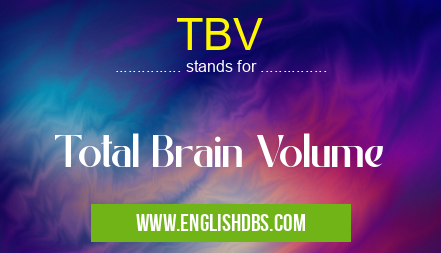What does TBV mean in UNCLASSIFIED
TBV, short for Total Brain Volume, is a crucial metric used in neuroimaging to assess the size and volume of the brain. It is a significant indicator of brain health, development, and function.

TBV meaning in Unclassified in Miscellaneous
TBV mostly used in an acronym Unclassified in Category Miscellaneous that means Total Brain Volume
Shorthand: TBV,
Full Form: Total Brain Volume
For more information of "Total Brain Volume", see the section below.
What is TBV?
TBV represents the total volume of the brain, including various brain tissues such as gray matter, white matter, and cerebrospinal fluid (CSF). It is typically measured in cubic centimeters (cm3) or milliliters (ml).
Importance of TBV
TBV plays a vital role in understanding brain health and function. It can provide valuable insights into:
- Brain growth and development
- Neurodegenerative diseases (e.g., Alzheimer's, Parkinson's)
- Brain injury or trauma
- Psychiatric disorders
- Treatment response and disease progression
Measuring TBV
TBV is commonly measured using magnetic resonance imaging (MRI) scans. MRI can accurately capture the brain's volume and differentiate between various brain tissues, allowing for precise TBV calculation.
Normal TBV Range
The normal range of TBV varies depending on age, sex, and individual factors. However, the average TBV for adults is approximately 1,260 cm3 for males and 1,130 cm3 for females.
Essential Questions and Answers on Total Brain Volume in "MISCELLANEOUS»UNFILED"
What is Total Brain Volume (TBV)?
Total Brain Volume (TBV) refers to the total amount of space occupied by brain tissue within the skull. It is a measure of the overall size of the brain and is commonly used in neuroimaging studies to assess brain development, aging, and disease progression.
How is TBV measured?
TBV can be measured using various neuroimaging techniques, such as magnetic resonance imaging (MRI) or computed tomography (CT). These techniques create detailed images of the brain, allowing researchers to estimate the volume of brain tissue.
What factors influence TBV?
TBV can be influenced by a variety of factors, including age, sex, genetics, and environmental factors. Brain volume typically increases during childhood and adolescence as the brain develops. However, TBV can decrease with age due to factors such as neurodegeneration or brain atrophy.
What are the normal ranges for TBV?
Normal TBV ranges vary depending on age, sex, and individual factors. However, the average TBV for adults is approximately 1,350 cubic centimeters.
How is TBV used in clinical practice?
TBV measurements can be used to assess brain health and detect abnormalities. Reduced TBV may be indicative of conditions such as Alzheimer's disease, multiple sclerosis, or brain injury. Conversely, increased TBV may be associated with certain developmental disorders.
What are the limitations of TBV measurements?
While TBV measurements can provide valuable insights into brain size and development, it is important to note that they have limitations. TBV does not measure brain function or activity, and it may not always be able to detect subtle changes in brain structure.
Final Words: TBV is an essential neuroimaging parameter that provides valuable information about the brain's size and volume. It is a key metric for assessing brain health, development, and function. Understanding the significance of TBV can aid in early detection, diagnosis, and management of various brain-related conditions.
